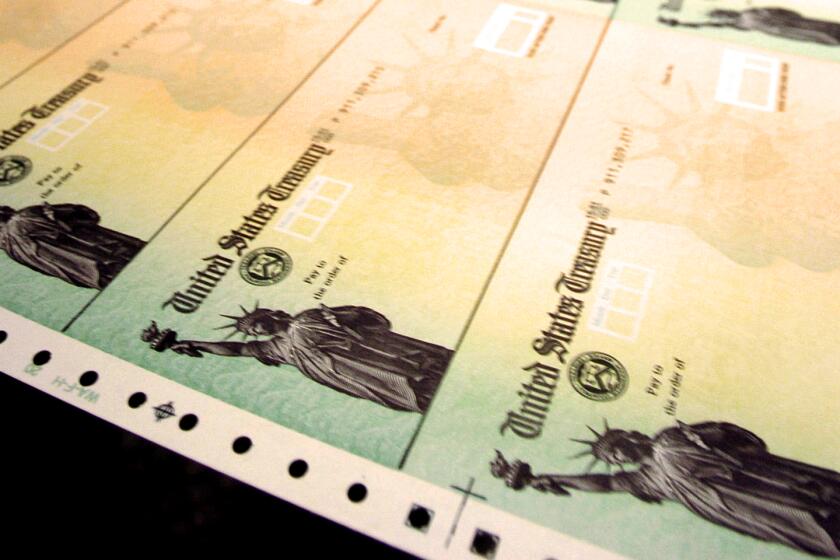POWER ON THE PACIFIC RIM : Market Scene : Seeing a Deal, Japan Takes the Thai Tack : The Southeast Asian nation has all the attributes industry hopes for: a large pool of workers, stability and tax incentives.
- Share via
BANG PA-IN, Thailand — By now, the story is painfully familiar. Like so many other industries back in the 1960s, U.S. firms enjoyed a near monopoly in the manufacture of precision bearings, the tiny steel balls that are crucial to the moving parts of everything from aircraft to videocassette players.
Along came Japanese competition, and the business virtually dried up in America, which today produces less than 1% of the world’s bearings. Even those are made by U.S.-based Japanese plants.
Perhaps less well known is the fact that Japan has now been overtaken by Thailand as the world’s major producer of precision bearings. One company alone accounts for 75% of the global output of miniature bearings.
The twist is that while the manufacturing may take place in Thailand, the company is still Japanese: a firm called Minebea Co., which early on appreciated the benefits of diversifying overseas.
Like scores of other Japanese companies, Minebea was faced in the 1970s with a desperate shortage of labor at home. It decided to simply relocate the production line, first to Singapore and then, beginning in 1982, to this Southeast Asian nation.
“Minebea has invested in the most advanced bearing factory in the world in Thailand,” said Morihiro Iijima, general manager of Minebea Thai. “We bought the most advanced machines from Japan, Switzerland and the United States. We trained our workers to the same standard as in Japan--two of our factories are now managed by Thais. We have taken the view that everything at our Thailand operation should be the same as in Japan.”
Now, Minebea is Thailand’s largest foreign-owned industrial company in terms of capital investment ($420 million) and the second-largest foreign employer, with 16,000 workers. So powerful and influential is the firm that it has a private waiting room for company VIPs at Bangkok’s Don Muang Airport and the only private helicopter allowed in the country.
What happened to Minebea is part of what Japan’s ambassador to Thailand, Hisahiko Okazaki, calls “the great relocation of industry” taking place throughout much of the Asia-Pacific region.
“Nobody in Japan wants to work in a factory anymore,” Okazaki said. “It’s better to use the space as a supermarket.”
Japanese industry, helped by a rapid rise in the value of the yen, in the early 1980s started moving manufacturing plants offshore to other Asian countries, first to the newly industrialized countries of Singapore, Hong Kong and South Korea, and then to Southeast Asia.
Places such as Malaysia also have flourished in the boom, with Japanese investment there doubling last year alone, but Thailand has become the real darling of Japanese business.
Now there are 20,000 Japanese business people and their families in Thailand, according to the Japanese Embassy. The Japanese Chamber of Commerce in Bangkok has 900 members, more than any other city in the world.
According to the Asian Bankers Assn., Japanese investment in Thailand rose from $250 million in 1986 to $3.5 billion in 1989. Similarly, the Thai board of investment reported that applications for new Japanese projects totaled $3 billion in 1990, while U.S. firms applied for only $1.1 billion.
Japan is not the only country to have climbed on Thailand’s bandwagon. Taiwan, South Korea and Hong Kong have also invested heavily here to take advantage of the cheap and plentiful labor.
Thailand has all the attributes a manufacturing industry could hope for: stability, tax incentives and, perhaps most important, a population of 56.7 million, which promises to provide plenty of workers for the foreseeable future at wages now averaging $120 a month.
As one Japanese businessman noted, Thais are predominantly Buddhist and thus make fewer demands of their employers then Muslims in neighboring Malaysia and Indonesia. In Thailand, the businessman added, men and women work together without cultural problems. They don’t fast during Ramadan, and they don’t take breaks for daily prayers and Friday visits to the mosque.
According to Minebea general manager Iijima, it was Thailand’s availability of labor rather than cheap wages that first attracted his company. Vutichai Udomkarnjananan, a Japanese-speaking Thai who runs Minebea’s personnel department, said that when the company’s first factory opened in 1982, there were 1,000 applicants for every job.
At Bang Pa-In, the firm’s largest facility, 8,727 workers--70% of them women--toil around the clock on three shifts, wearing gray or blue uniforms and Mao hats with the company logo. Like most Japanese companies, Minebea works a six-day, 48-hour week, with one Saturday off a month.
Iijima said that workers at Minebea receive the same flat salary of 4,000 baht ($160) a month, regardless of their job on the factory floor. Higher salaries are paid to “team leaders” and others who have been promoted.
The company provides transportation to work, free medical care and uniforms, as well as a free midday meal of rice.
Nearly 1,000 employees at Bang Pa-In have been sent for training in Japan, including technicians who spend between six months and four years at Minebea factories.
“We could train them here in Thailand, but we like them to see how we live and work in Japan,” Iijima said. “For example, they see how clean Japanese factories are, and when they come back here they keep the workplace just as clean.”
Indeed, each shift begins with a rousing speech from the section leader urging the workers to scale new heights of production and quality. Thai rock ‘n’ roll provides a syncopated beat on the factory floor as the thousands of women assemble the tiny electronic components with incredible precision.
“Some of these jobs are so small it’s almost impossible to automate them,” Iijima said.
Despite the apparent tedium of the work, company officials said the turnover rate among workers is less than 1% a year.
As in most Japanese companies, promotions at Minebea depend on seniority. But officials maintain that they have been equitable with Thai management members and that about a dozen senior personnel in the company are local. Minebea has 170 Japanese managers and technicians working in Thailand.
One frequent accusation made against Japanese companies in Thailand is that they are reluctant to buy components from local suppliers. What they don’t make themselves, they import from back home.
Iijima said this was once true at Minebea because it was company policy to “produce everything ourselves.” Under pressure from the Thai government, however, Minebea now buys about 20% of its components on the local Thai market, often training the suppliers to meet Japanese quality standards.
The pressure from the Board of Investment was a rare intrusion into the operation of a foreign factory here. In fact, Japanese company officials cite Thailand’s lack of government interference as another key reason so many companies have chosen to set up operations here.
The Thais have also given generous tax incentives to new projects. Land is still relatively cheap, especially compared to Japan, though most industrial parks are now full.
Okazaki, the Japanese envoy, noted that Thailand was the only country in Southeast Asia not conquered militarily by Japan during World War II. He said that, unlike in China, there is little animosity toward Japanese.
According to the Asian Bankers Assn. study, about 80% of Japanese investment in Southeast Asia has been in export-oriented projects, such as plants to make TV sets and microwave ovens.
Virtually all of Minebea’s production is exported. About 65% of output goes to Japan for inclusion in Japanese goods, with the remainder divided between the United States and Europe.
With Japan’s overseas markets in Europe and the United States stagnant with recession, more Japanese companies are looking to Asia itself as a marketplace. In a historic reversal of trade patterns, Japan is now exporting more to Southeast Asia than to the United States, and in three or four years Japan is expected to replace the U.S. market as Thailand’s biggest overseas customer.
Underlining the changing realities of consumer goods production, the demand for color television sets in Asia is now 10 times larger than in the United States.
Japanese car makers saw demand rise a healthy 17% last year in Asia, where sales of their autos now total nearly one-third of the giant U.S. market. In Thailand and Indonesia, demand increased 50%. Because of import restrictions in many Asian countries, auto makers have had to set up local companies to assemble the cars.
In late April, Japan approved a $480 million loan for Thailand to be used primarily for infrastructure projects. Not coincidentally, Japanese firms often bring home the lion’s share of these projects.
In contrast, the United States had budgeted $17 million in assistance for Thailand this year, but the aid was suspended after a coup attempt in February.
Elsewhere in Southeast Asia, the story is much the same. The Philippines received $405 million from Japan in 1989, but only $150 million from its traditional patron, the United States.
Japan has given more than $3.5 billion in loans and grants to Malaysia since the end of World War II. In one instance, a $350-million government loan to help the Perwaja national steel project in 1982 was used to buy technology from Nippon Steel--but the Japanese prototype plant was defective and the Malaysian company ran up heavy losses.
Japanese studies provide a virtual economic blueprint for Malaysia’s development, with the advice occasionally raising the hackles of local business people who feel it has become too intrusive.
“Japan sets the agenda for industrialization in Southeast Asia,” Chandra Muzaffar, a Malaysian social scientist, told the Far Eastern Economic Review earlier this year. “This is in the nature of economies that are dependent and economies that are in a position to dictate.”
A Japanese Success in Thailand Japanese owned Minebea Co.’s Thai operation is the world leader in precision bearings and the world’s second largest supplier of floppy disk drives for computers. Its other products include precision motors, power supplies, computer keyboards and desk-top calculators.
Minebea officials said the availability of labor attracted the company to Thailand, where operations were established more than eight years ago. Virtually all of Minebea’s production in Thailand is exported. About 65% of output goes to Japan for inclusion in Japanese goods, with the remainder divided between the United States and Europe. Here’s a look at the firm: Minebea Group Core Company: Minebea Co. Employees: More than 30,000. Factories: 50 plants in Thailand, Singapore, Japan, United States and Britain. Subsidiaries: 68 subsidiaries and affilated companies in 21 countries; 214 international sales offices. 1990 SALES BREAKDOWN: Ball bearings: 30% Electronic equipment and parts: 43% Machinery parts: 12% Special machinery parts and other: 15%
Projection: Minebea is aiming for profit of 7 billion yen ($51.9 million) for fiscal 1991 and hopes to double that by the end of fiscal 1993. A three-year plan focuses on expanding business in existing areas, specifically in electronic components.
NOTE: Exchange rates at the end of reporting periods: 135 yen to $1 for 1986-’88; 133.80 yen to $1 for 1989; 147.83 yen to $1 for 1990
Source: Minebea Co.; Japan Company Handbook, Winter 1989
More to Read
Inside the business of entertainment
The Wide Shot brings you news, analysis and insights on everything from streaming wars to production — and what it all means for the future.
You may occasionally receive promotional content from the Los Angeles Times.










